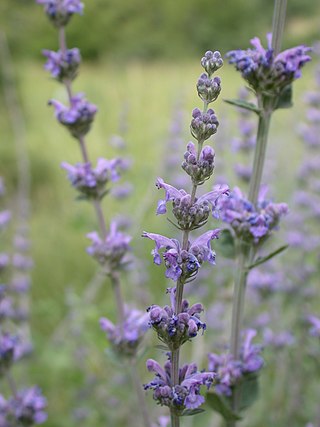
China, officially the People's Republic of China (PRC), is a country in East Asia. With a population exceeding 1.4 billion, it is the world's second-most populous country after India, representing 17.4% of the world population. China spans the equivalent of five time zones and borders fourteen countries by land. With an area of nearly 9.6 million square kilometers (3,700,000 sq mi), it is the third-largest country by total land area. The country is divided into 33 province-level divisions: 22 provinces, five autonomous regions, four municipalities, and two semi-autonomous special administrative regions. Beijing is the country's capital, while Shanghai is its most populous city by urban area and largest financial center.

Nepeta is a genus of flowering plants in the family Lamiaceae. The genus name, from Latin nepeta (“catnip”), is reportedly in reference to Nepete, an ancient Etruscan city. There are 295 accepted species.

Hong Kong is a special administrative region of the People's Republic of China. With 7.4 million residents of various nationalities in a 1,104-square-kilometre (426 sq mi) territory, Hong Kong is the fourth most densely populated region in the world.

Taiwan, officially the Republic of China (ROC), is a country in East Asia. The main island of Taiwan, also known as Formosa, lies between the East and South China Seas in the northwestern Pacific Ocean, with the People's Republic of China (PRC) to the northwest, Japan to the northeast, and the Philippines to the south. It has an area of 35,808 square kilometres, with mountain ranges dominating the eastern two-thirds and plains in the western third, where its highly urbanized population is concentrated. The combined territories under ROC control consist of 168 islands in total covering 36,193 square kilometres. The largest metropolitan area is formed by Taipei, New Taipei City, and Keelung. With around 23.9 million inhabitants, Taiwan is among the most densely populated countries.

Abelia is a genus of flowering plants in the honeysuckle family, Caprifoliaceae. The genus currently includes six species native to China, Taiwan, and Vietnam.

Pimelea, commonly known as rice flowers, is a genus of plants belonging to the family Thymelaeaceae. There are about 150 species, including 110 in Australia and 36 in New Zealand.

Macroglossum milvus is a moth of the family Sphingidae. It is known from Réunion and Mauritius.

Macroglossum vicinum, or Jordan's hummingbird hawkmoth, is a moth of the family Sphingidae. It is known from southern India, southern China and Thailand.

Styphelia tubiflora, commonly known as red five-corners, is a species of flowering plant in the heath family Ericaceae and is endemic to eastern New South Wales. It is an erect to spreading shrub with oblong to egg-shaped leaves with the narrower end towards the base, and usually red, tube-shaped flowers.

Riedelia is a genus of plants in the family Zingiberaceae. The genus contains approximately 75 species that are distributed among New Guinea, the Solomon Islands, and Maluku Province in eastern Indonesia. Among the described species is Riedelia charontis, which was formally described in 2010.

Buddleja curviflora is a deciduous shrub native to southern Japan and Taiwan, where it grows in thickets on stony slopes at elevations of 100–300 m. B. curviflora was named and described Hooker and Arnott in 1838. Plants in Taiwan have been described as a separate species Buddleja formosana and assessed as Critically Endangered by IUCN, but the distinction is not recognized by Li and Leeuwenberg, who sank formosana as a synonym.

Alibertia is a genus of flowering plants in the family Rubiaceae. It is found in tropical America. They are dioecious trees or shrubs, with white flowers and indehiscent, often fleshy fruit.
Agouticarpa is a genus of flowering plants in the family Rubiaceae. It was described by Claes Persson in 2003. The genus is found from Costa Rica to Bolivia.

Chassalia is a genus of flowering plants in the family Rubiaceae. The genus is found from tropical Africa to (sub)tropical Asia.
Palicoureeae is a tribe of flowering plants in the family Rubiaceae and contains about 817 species in 11 genera. Its representatives are found in the tropics and subtropics.

Ebony Forest Reserve Chamarel or just the "Ebony Forest" is a 50 ha conservation area for Mauritian endemic species with a rehabilitated indigenous forest, situated in Chamarel, in the south-west of Mauritius.

Pimelea curviflora, also known as curved rice-flower, is a shrub in the family Thymelaeaceae and is endemic to Australia. It is a small, hairy shrub with greenish-yellow or red tubular flowers.
Schwenckia is a genus of flowering plants in the family Solanaceae, native to Central America and South America, and with one species, S. americana, a widespread weed in Africa. In the title of the generic description Linnaeus wrote "Schwenkia" but gave the binomial of the type species as Schwenckia americana, while quoting Dav. van Royen as the author.

Nepeta curviflora, commonly known as Syrian catnip, is a herbaceous flowering plant native to the Middle East. It was first described in 1844.

















